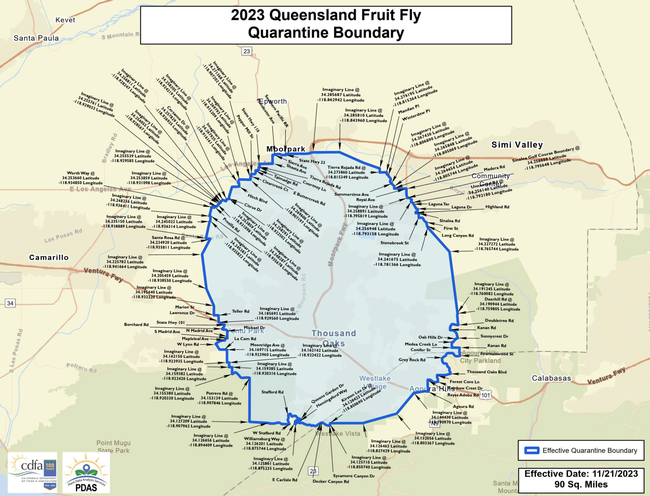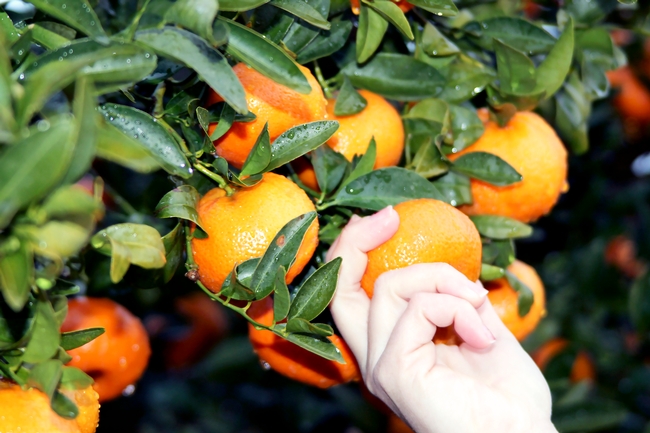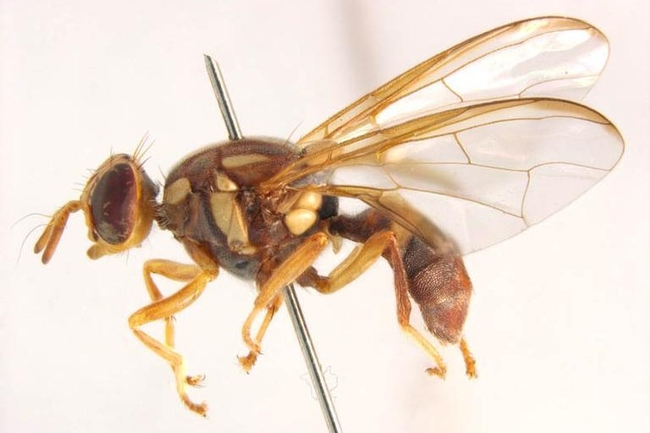Posts Tagged: quarantine
Lawn-pocalypse! Surviving Drought
Ah, summer! The season of sunburns, pool parties, and… lawn droughts. If your once lush, green carpet now looks like a crunchy brown doormat, you're not alone. Let's dive into why your yard is staging a dramatic death scene and what you can do to...

Bermuda grass and weeds overtaking drought stressed turf grass.
When Quarantined, What Do Growers Do?
Queensland fruit fly quarantine?
Growers should consider the pre-quarantine program.
The Queensland fruit fly quarantine zone has been expanded (see: https://www.cdfa.ca.gov/plant/qff/regulation.html). Queensland fruit fly (also called QFF or Qfly) is a concern because it has over a hundred host plants and causes severe fruit damage. Like other tephritid fruit flies, it is challenging to control once the population takes hold.
What does this mean for growers in the quarantine zone? If a grower is in the zone (regardless of if they have Qfly on their ranch), their crop is on hold for one life cycle. Based on the weather, the life cycle length can vary. In the winter, life cycles are generally around 90 days. In the summer, the life cycle is about 30 days. Growers can view the length of the fruit fly life cycle here to determine how long the holding period is: https://www.cdfa.ca.gov/plant/pe/InteriorExclusion/pdf/QFF_Ventura_County-Thousand%20Oaks-2023-2024PreharvestTreatmentSchedule.pdf
During this holding period, growers must treat their crop repeatedly until the holding period expires. Growers must treat with Malathion + NuLure every 6-14 days for the duration of the holding period. This is a bait spray that must be mixed. To use Malathion, growers will need to notify the county ag commissioner and will need to register for special local need usage. For an additional option, growers can instead use GF-120 Spinosad bait every 7-10 days. GF-120 is premixed and therefore easier to use, but costs more than Malathion. When selecting which bait to use, growers should consider PHI for their crop and harvesting intervals. For example, GF-120 has a 4 hour PHI and Malathion has a 3 day PHI for strawberries – if a grower is harvesting every week, they may want to use GF-120. Growers need to spray bait around the perimeter of each field and throughout the field at spaced intervals.
Growers must comply with the treatment intervals, or they will have to start the holding period over.
After treatment, growers will receive a permit that is valid for 10 days and allows for movement of the crop.
If a grower is near the quarantine zone and anticipates economic losses due to a long holding period should they fall under quarantine, they can voluntarily opt to join a pre-quarantine program. The pre-quarantine program is overseen by the county. Treatments applied during the pre-quarantine period count towards the holding period if a grower falls under quarantine later on. This reduces the amount of time that the crop is on hold. This is a proactive measure that is optional. Please direct questions about the pre-quarantine program to the pest exclusion program at the Ventura County's Agricultural Commissioner's Office (806-388-4222 ext. 7165) or UC ANR at hcohen@ucanr.edu
Quarantine regulations apply to most crops within the quarantine zone, but 'Hass' avocado has been excluded from the host list for Queensland Fruit Fly and Oriental Fruit Fly and is not subject to quarantine regulations
More complete information regarding the mitigations required for citrus movement may be found on the Citrus Grower/Grove Manager Information page: https://phpps.cdfa.ca.gov/PE/InteriorExclusion/pdf/acpgrowerinformation.pdf

QLFF fly quarantine area
First-ever Queensland fruit fly quarantine restricts moving homegrown produce
QFF quarantine in LA, Ventura counties among seven fruit fly quarantines statewide
Residents in multiple Southern California and Northern California counties should not move homegrown fruits and vegetables from their properties to help contain several species of fruit fly that can destroy crops and impact the livelihoods of local farmers.
With sharing and gifting of food integral to the holiday season, the California Department of Food and Agriculture is reminding people to heed the seven active fruit fly quarantines aimed at controlling the Mediterranean fruit fly, Oriental fruit fly, Tau fly and Queensland fruit fly. The links below describe quarantine zone boundaries:
- Mediterranean fruit fly: Los Angeles County, Leimert Park Area
- Oriental fruit fly: San Bernardino and Riverside Counties, Redlands and Yucaipa Areas
- Oriental fruit fly: Sacramento County, Rancho Cordova Area
- Oriental fruit fly: Contra Costa County, Brentwood Area
- Oriental fruit fly: Santa Clara County, Santa Clara Area
- Tau fly: Los Angeles County – Stevenson Ranch, Valencia, Santa Clarita Areas
- Queensland fruit fly: Ventura and Los Angeles Counties, Thousand Oaks Area
People within these zones should consume or process (i.e., juice, freeze or cook) their homegrown fruits and vegetables at the place of origin and not move them off their property. Uneaten produce should be double-bagged in plastic bags and disposed of in the landfill bin – not compost or green waste.
Queensland fruit fly threatens California citrus, other crops
The Queensland fruit fly (Bactrocera tryoni) quarantine is the first of its kind in the U.S. Although QFF was first seen in California in 1985, the recent detection of two adult males triggered the unprecedented quarantine action by USDA's Animal and Plant Health Inspection Service and CDFA.
“This pest has earned a bad reputation for wreaking havoc on fruit production in Australia, where it is native,” said Hamutahl Cohen, University of California Cooperative Extension entomology advisor for Ventura County. “Adult flies lay their eggs in fruit, and the eggs hatch into larvae that then feed on the fruit, causing damage.”
And while females of other fruit fly species live for only two or three months, QFF females are unique in that they can live up to a year, according to Cohen.
“Once QFF populations take root, they're challenging to manage because females can each lay up to 100 eggs per day,” Cohen said.
In addition to being highly adaptable to a variety of environmental conditions, QFF has more than 170 host plants – including a wide range of California commodities such as citrus, grape, strawberry, fig, avocado, apricot, peach, cherry, nectarine, plum, pear, apple, tomato and sweet pepper.
The threat to citrus is especially concerning, as Southern California growers continue to grapple with the specter of spreading huanglongbing (HLB) disease, which kills citrus trees. Cohen said residents of citrus-growing regions can do their part to help their neighbors and local economy by respecting quarantine restrictions.
“Growers are already dealing with other invasive species like Asian citrus psyllid [vector of HLB pathogen], so we as homeowners need to prevent the spread of fruit flies to reduce the burden on them,” she explained.
While a spike this year in the detections of multiple fruit fly species was likely caused by a host of factors, Cohen speculates that increased post-pandemic travel is helping to move the flies. And with holiday travel in full swing, she said it's important to practice “Don't Pack a Pest” principles.
“Invasive species often hitchhike on fruits and vegetables brought into California by travelers – that's why we often first find invasive species in urban and suburban backyards, and not on farms,” Cohen said. “Travelers entering the U.S. can visit dontpackapest.com to learn about which products they can and cannot bring back with them.”
To report a suspected infestation of fruit fly larvae in homegrown produce, call the CDFA pest hotline at 1-800-491-1899. Growers with questions and concerns are urged to contact their local agricultural commissioner's office.
Parasitic weeds threaten tomato plants on California farms
Hanson and team battle invasive species At first glance, Orobanche ramosa looks like an interesting blossoming plant, one that could add a unique flair to flower arrangements. But it's a parasitic weed that attaches to roots, sucks out nutrients and is...
What Happens in a Quarantine?
The recent find of an infected adult Asian citrus psyllid in Santa Paula prompted the search for the potentially infected tree by CA Department of Food and Agriculture personnel to spread out to look and test. Two trees were found and presumably they will be destroyed. This now prompts a much more intense survey of the surrounding 2/10ths of a mile of those trees. It also places a quarantine on the movement of fruit out of that area, extending out 5 miles. That means no fruit or plant parts should be taken out of the area, potentially spreading the insects and disease to other areas, unless those plant parts have been properly treated. You can read more about the actions taken in a quarantine when infected insects or plants are found HERE . And in this document you can read about the details in and around a quarantined area and how the fruit and plants should be treated HERE.
As is the case in the spread of many invasive pests, it is humans that can be the main mode of movement of the pest and disease.

ACP nymphs sam droege


